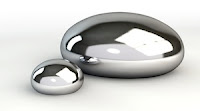Mercury Element Facts and Figures
By Anne Marie Helmenstine, Ph.D.
10 Mercury Facts (Element)
Mercury is a shiny, silvery liquid metal, sometimes called quicksilver.
It is a transition metal with atomic number 80 on the periodic table, atomic weight of 200.59, and the element symbol Hg.
Here are 10 interesting element facts about mercury.
.
1. Mercury is the only metal that is a liquid at standard temperature and pressure.
 The only other liquid element under standard conditions is bromine (a halogen), although the metals rubidium, cesium, and gallium melt just warmer than room temperature.
The only other liquid element under standard conditions is bromine (a halogen), although the metals rubidium, cesium, and gallium melt just warmer than room temperature.
Mercury has a very high surface tension, so it forms rounded beads of liquid.
2. Although mercury and all of it compounds are known to be highly toxic, it was considered therapeutic throughout much of history.
3. The modern element symbol for mercury is Hg, which is the symbol for another name for mercury: hydrargyrum.
Hydrargyrum comes from Greek words for "water-silver" (hydra - means water, argyros means silver).
4. Mercury is a very rare element in the Earth's crust. It accounts for only about only 0.08 parts per million (ppm).
It is mainly found in the mineral cinnabar, which is mercuric sulfide.
Mercuric sulfide is the source the red pigment called vermilion.
5. Mercury generally is not allowed on aircraft because it combines so readily with aluminum, a metal that is common on aircraft.
When mercury forms an amalgam with aluminum, the oxide layer that protects aluminum from oxidizing is disrupted.
This causes aluminum to corrode, in much the same way as iron rusts.
6. Mercury does not react with most acids.
7. Mercury is a relatively poor conductor of heat.
Most metals are excellent thermal conductors. It is a mild electrical conductor.
The freezing point (-38.8 degrees Celsius) and boiling point (356 degrees Celsius) of mercury are closer together than for any other metals.
8. Although mercury usually exhibits a +1 or +2 oxidation state, sometimes it has a +4 oxidation state.
The electron configuration causes mercury to behave somewhat like a noble gas.
It forms amalgams with all the other metals, except for iron. This makes iron a good choice to make containers to hold and transport mercury.
9. The element Mercury is named for the Roman god Mercury.
Mercury is the only element to retain its alchemical name as its modern common name.
The element was known to ancient civilizations, dating back to at least 2000 BC.
Vials of pure mercury have been found in Egyptian tombs from the 1500s BC.
10.Mercury is used in fluorescent lamps, thermometer, float valves, dental amalgams, in medicine, for the production of other chemicals, and to make liquid mirrors.
Mercury(II) fulminate is an explosive used as a primer in firearms.
The disinfectant mercury compound thimerosal is an organomercury compound sound in vaccines, tattoo inks, contact lens solutions, and cosmetics.
You might also like:
.
CLICK HERE . . .
CLICK HERE . . .
.
.
Polyethelyne
CLICK HERE . . .
 |
Multi-Media Filter, Highly-Activated Carbon Filter,
Zeolite-Process Water Softener With Brine Tank,
Fiberglass Ballast-Type Pressure Tank
(fully automatic backwash & regeneration)
|
PURICARE
Water
Treatment
Systems
.
.
...
Aganan, Pavia, Iloilo, Philippines
...
CLICK HERE . . . to view company profile . . .
http://puricare.blogspot.com/p/company-profile.html

CLICK HERE . . . to view company profile . . .
 |
| FIRSTANK Polyethelene Tanks |

 | ||
|
|













Hi There,
ReplyDeleteThank you for sharing the knowledgeable blog with us I hope that you will post many more blog with us:-
Sodium cyanide is a poisonous compound with the formula NaCN. It is a white, water-soluble solid. Cyanide has a high affinity for metals.
Click here for more information:- more info
Hi There,
ReplyDeleteThank you for sharing the knowledgeable blog with us I hope that you will post many more blog with us:-
Pure Mercury, Sodium Cyanide, 99.99% silver liquid mercury, Cinnabar, Mercury antimony oxide.We supply high grade & perfectly composed Pure Sodium Cyanide online at cheap & affordable prices.
Click here for more information:- more info
Hi There,
ReplyDeleteThank you for sharing the knowledgeable blog with us I hope that you will post many more blog with us:-
Agricultural poisons, anti-fouling paint, dental amalgams, minning, electronics, and chemical synthesis etc..
.
Click here for more information:- MORE DETAILS......